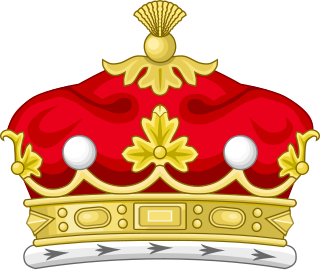Related Research Articles

Ardfert is a village and civil parish in County Kerry, Ireland. Historically a religious centre, the economy of the locality is driven by agriculture and its position as a dormitory town, being only 8 km (5 mi) from Tralee. The population of the village was 749 at the 2016 census.

Marquess of Lansdowne is a title in the Peerage of Great Britain created in 1784, and held by the head of the Petty-Fitzmaurice family. The first Marquess served as Prime Minister of Great Britain.
Earl of Glandore, in the County of Kerry, was a title in the Peerage of Ireland. It was created in 1776 for the Irish politician William Crosbie, 2nd Baron Brandon.
This is a list of people who have served as Lord Lieutenant of Kerry.
Robert Maxwell, 1st Earl of Farnham PC, styled The Honourable Robert Maxwell from 1756 to 1759, was an Irish peer and a Member of both the Parliament of Great Britain and the Parliament of Ireland.

Charles Bingham, 1st Earl of Lucan, known as Sir Charles Bingham, 7th Baronet, from 1750 until 1776, was an Irish peer and politician.

Edward Ward, styled The Honourable from 1770, was an Irish politician.
John Petty Fitzmaurice, 1st Earl of Shelburne PC (Ire), known as John FitzMaurice until 1751 and as The Viscount FitzMaurice between 1751 and 1753, was an Anglo-Irish peer and politician. He was the father of William Petty FitzMaurice, Prime Minister of Great Britain from 1782 to 1783.

Richard Child, 1st Earl Tylney, was an English politician who sat in the House of Commons between 1708 and 1734. Initially a Tory, he switched to supporting the Whigs after 1715. He held no Office of State, nor any commercial directorship of significance, but is remembered chiefly as the builder of the now long-demolished Palladian "princely mansion" Wanstead House, one of the first in the style constructed in Britain. In the furnishing of his mansion Child became the main patron of the Flemish painter Old Nollekens. He died in March 1750 aged 70 at Aix-en-Provence, France, and was buried on 29 May 1750 at Wanstead.
Sir Richard Levinge, 1st Baronet was an Irish politician and judge, who played a leading part in Irish public life for more than 30 years.
William Crosbie, 1st Earl of Glandore, known as The Lord Brandon between 1762 and 1771 and as The Viscount Crosbie between 1771 and 1776, was an Irish politician.

John Crosbie, 2nd Earl of Glandore PC, FRS, styled Viscount Crosbie between 1777 and 1781, was an Irish politician.
The High Sheriff of Kerry was the British Crown's judicial representative in County Kerry, Ireland from the 16th century until 1922, when the office was abolished in the new Free State and replaced by the office of Kerry County Sheriff. The sheriff had judicial, electoral, ceremonial and administrative functions and executed High Court Writs. In 1908, an Order in Council made the Lord-Lieutenant the Sovereign's prime representative in a county and reduced the High Sheriff's precedence. However, the sheriff retained his responsibilities for the preservation of law and order in the county. The usual procedure for appointing the sheriff from 1660 onwards was that three persons were nominated at the beginning of each year from the county and the Lord Lieutenant then appointed his choice as High Sheriff for the remainder of the year. Often the other nominees were appointed as under-sheriffs. Sometimes a sheriff did not fulfil his entire term through death or other event and another sheriff was then appointed for the remainder of the year. The dates given hereunder are the dates of appointment. All addresses are in County Kerry unless stated otherwise.
Maurice Crosbie, 1st Baron Brandon, was an Irish politician and peer.
Custos rotulorum is the keeper of a county's records and, by virtue of that office, the highest civil officer in the county.
Walter Jones was an Irish politician from County Leitrim. He held local offices in Leitrim and some minor national patronage offices, and entered Parliament on the interest of his relatives the Beresford family.
Lancelot Crosbie was an Anglo-Irish politician.
Hercules Langford Rowley PC was an Irish politician and landowner.

Ballyheigue Castle, in Ballyheigue, County Kerry, is a ruined Tudor-gothic-revival-style mansion. It was used as a residence of the Crosbie family and later as a gaol. It has been burned twice. It is currently part of a golf course.
James Dayrolles Crosbie was an Irish Justice of the Peace (JP), High Sheriff and Deputy Lieutenant (DL) of County Kerry and a Brigadier-General in the British Army during World War I. He was the last in the Crosbie line to live in Ballyheigue Castle.
References
- ↑ Leigh Rayment's Historical List of MPs – Constituencies beginning with "K" (part 1)
- 1 2 3 Jupp, P. J. (1986). R. Thorne (ed.). "CROSBIE, James (c.1760-1836), of Ballyheigue Castle, co. Kerry". The History of Parliament: the House of Commons 1790-1820. Boydell and Brewer. Retrieved 8 June 2014.
- ↑ Lundy, Darryl. "Colonel James Crosbie". ThePeerage.com. Retrieved 8 June 2014.
- ↑ Leigh Rayment's historical List of Members of the Irish House of Commons . Cites: Johnston-Liik, Edith Mary (2002). The History of the Irish Parliament 1692-1800 (6 volumes). Ulster Historical Foundation.